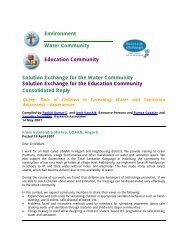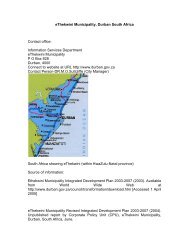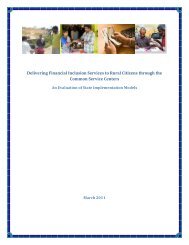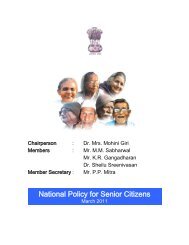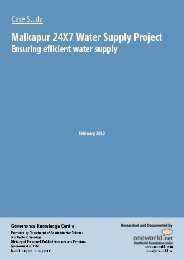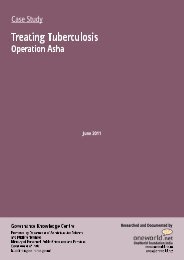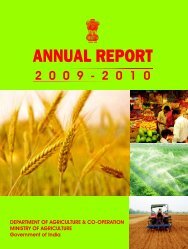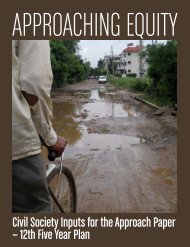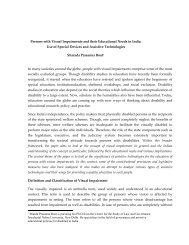Improving urban water services - SASANet
Improving urban water services - SASANet
Improving urban water services - SASANet
- No tags were found...
Create successful ePaper yourself
Turn your PDF publications into a flip-book with our unique Google optimized e-Paper software.
Section 1: Introductionthird of a set of three WaterAid discussion papers on how to improve <strong>urban</strong> <strong>water</strong>and sanitation <strong>services</strong> for poor people. It was written as part of the preparation fora workshop for training of trainers on civil society participation in <strong>urban</strong> <strong>water</strong>reform, organised by WaterAid in Nepal in July 2009. The paper draws on a variety ofliterature, as well as a series of key-informant interviews.DefinitionsUtility/ServiceProvider:User:these terms are used in this paper interchangeably, to denote “anorganisation, whether public or private, that provides <strong>water</strong> <strong>services</strong> ofa public service nature”, 5 taking into consideration that while in somecontexts <strong>urban</strong> <strong>water</strong> provision is delivered by <strong>water</strong> companies, in othersprovision is undertaken by local governments.any person utilising <strong>urban</strong> <strong>water</strong> <strong>services</strong>: service users are referred to inthe reviewed literature and interviews in various ways, including consumers,customers and citizens. These distinctions are “reflected in the [socialaccountability] tools themselves, with some of the tools (such as legalredress) viewing the user as a citizen, others (such as consumer <strong>services</strong>)viewing the user as a consumer, and a third group (such as complaintsmechanisms) identifying the user as a formal, contractual customer”. 6 Theterm ‘users’ is used throughout this paper, excluding quotes or case studies,to avoid making such distinctions within the general arguments presented.5 WB 2008a p16 WB 2008a p24 Social accountability: Tools and mechanisms for improved <strong>urban</strong> <strong>water</strong> <strong>services</strong>
Section 1: IntroductionSection 2Routes to accountabilityThe failure of <strong>urban</strong> <strong>water</strong> utilities or providers to respond to the needs of poorpeople has resulted in a focus on ways to improve their accountability, andsubsequently their responsiveness to user demands.Accountability is defined by the World Bank 7 as “a set of relationships among servicedelivery actors with five features:• Delegating: Explicit or implicit understanding that a service (or goods embodyingthe service) will be supplied.• Financing: Providing the resources to enable the service to be provided or payingfor it.• Performing: Supplying the actual service.• Having information about performance: Obtaining relevant information andevaluating performance against expectations and formal or informal norms.• Enforcing: Being able to impose sanctions for inappropriate performance orprovide rewards when performance is appropriate”.WaterAid/Marco BettiEnsuring <strong>water</strong> users have access to relevant information is key to providers’ accountability.7 2003 p48Social accountability: Tools and mechanisms for improved <strong>urban</strong> <strong>water</strong> <strong>services</strong>5
Section 2: Rules to accountabilityAn important model for analysis of service provision, using the terms ‘long’ and‘short’ routes to accountability, was developed by the World Bank, and establishedas a framework for analysis in its 2004 annual report, Making Services Work forPoor People 8 (see Figure 1). Under the ‘long’ route, citizens use their ‘voice’ to exertpressure on policy makers to ensure service providers deliver affordable accessto <strong>services</strong> for poor people. However, this traditional approach to service provisionoften fails due to the generally weak voice of poor citizens and the vulnerabilityof <strong>services</strong> to patronage politics (ibid), as well as the weakness or absence ofdemocratic institutions through which citizens’ voices can be channelled. 9 The lackof a clear institutional separation between policy making and service provision mayalso affect the ability of policy makers to hold providers accountable, and strongindependent regulatory institutions are often absent. Franceys and Gerlach 10 go sofar as to argue that “…the long route has tended to become so distorted that anadequate voice has never reached the service providers”.Figure 1: The long and short routes to accountabilityThe stateVoicePoliticiansPolicy makersCompactLong route to accountabilityCitizens/clientsShortrouteProvidersCoalitions/inclusionsManagementNonpoor PoorClient powerFrontline OrganisationsServicesSource: WB 2008 p8The difficulties of citizen engagement with the long route have led to greater relianceon direct user influence – the short route – implying direct application of voiceto hold providers accountable. This route is enhanced when citizens’ voices areaccompanied by payment for <strong>services</strong>. McIntosh 11 refers to the example of <strong>water</strong>utilities in Bangkok and Singapore to argue that paying the full cost of <strong>water</strong><strong>services</strong> (through a viable tariff structure) may in some cases put users in control18 WB 200319 WaterAid 200610 2008 p1611 20036 Social accountability: Tools and mechanisms for improved <strong>urban</strong> <strong>water</strong> <strong>services</strong>
Section 2: Rules to accountabilityand apply pressure for service improvement (although naturally the extent to whichthis is possible is context-specific). The underlying assumption is that when themoney trail runs directly from user to provider, corruption opportunities are reducedand accountability, transparency and information flows are enhanced. This isparticularly apparent where a change in the set of relationships allows the delegationof the direct service provision to some other entity other than the policy maker.However, despite potentially allowing a more direct and immediate influence onproviders, the advantages of using the short route should not be exaggerated.The World Bank, for example, warns against a focus on this route which neglects thepolitical context in which service providers operate and abandons other importantways in which citizens can influence accountability, such as through politicalrepresentation of citizens’ interests. In addition, it argues that the long route isessential to give voice to the unserved, who do not (yet) have a direct relationshipwith providers 12 – certainly the case for many poor people in <strong>urban</strong> areas,particularly those residing in informal settlements. Even when they are served, poorindividuals face substantial barriers to using their voice to exert demands on serviceproviders, such as lack of collective organisation, lack of information and education,social exclusion (on account of social class, poverty, place of residence, ethnicity,disability or gender) and financial and time constraints. It is therefore important thatthe use of the short route does not result in abandonment of the long route toaccountability. Section 3 attempts to address these issues by examining the roleof social accountability mechanisms in enhancing both routes to accountability.12 WB 2008aSocial accountability: Tools and mechanisms for improved <strong>urban</strong> <strong>water</strong> <strong>services</strong>7
Running headSection 3Social accountabilitya BackgroundThe issue of social accountability is of crucial importance to <strong>water</strong> provision forpoor people living in <strong>urban</strong> settings. Urban <strong>water</strong> <strong>services</strong> are often delivered ata decentralised level, where capacities may be weak and resources limited, andcentral or local governments may delegate service provision to other providers(such as private companies, under privatisation or service-delivery contracts). Undersuch circumstances, a change is created in the set of relationships governing the‘social contract’ between the state and its citizens. In some cases, users may findthemselves unable to hold the delegated providers to account 13 as a result, while inothers service delegation may allow more direct provider-user links than previously,and thus perhaps greater accountability.Balazs Gardi/Facing<strong>water</strong>crisis.org/VII NetworkTruck drivers fill <strong>water</strong> tankers at a pumping station in Orangi Town in Karachi, Pakistan.13 WaterAid 20068 Social accountability: Tools and mechanisms for improved <strong>urban</strong> <strong>water</strong> <strong>services</strong>
Section 3: Social accountabilityOver the past few years there has been growing interest among various civil societyactors and development agencies in social accountability mechanisms. The conceptof social accountability “affirms direct accountability relationships between citizensand the state and puts them into operation… [it] refers to the broad range of actionsand mechanisms…that citizens can use to hold the state to account, as well as theactions on the part of government, civil society, media, and other societal actors thatpromote or facilitate these efforts”. 14Social accountability mechanisms aim to enable civil society actors to engage withprocesses such as policy making, service delivery, budget preparation and analysis,expenditure tracking, and performance monitoring of service provision, 15 in a way thatexpresses demand towards and exacts accountability from government and providersto improve service quality. 16 Social accountability mechanisms can be initiated andsupported by the state, citizens or both, but very often are demand-driven andoperated from ‘the bottom up’. At the same time, they allow providers to improve theefficiency and quality of <strong>services</strong> and organisational structures, while improving theirrelationship with users and increasing revenue by growing their customer base. 17Social accountability mechanisms, created through the use of a variety of tools onboth the supply and demand side, and applied in a context-specific manner, play arole in improving both short and long routes to accountability. This paper focuses toa greater extent on the short route, namely the use of mechanisms that enhance theinteraction between service providers and users. A list of tools available to providersand users for enhancing social accountability is provided in Appendices one and tworespectively, describing each tool and providing references for further reading.The principles underlying these tools are discussed next.b Principles of social accountability tools 18While the principles of user- and provider-side mechanisms are discussed separatelybelow, an overarching guiding principle underlying these mechanisms is equity andinclusion. Due consideration should be given to issues that tend to form the basisfor exclusion of some people from <strong>services</strong>, such as gender, social class, age, ethnicminorities, disability, seasonal migration etc. An exhaustive list cannot be providedhere as these issues are specific to each context. Further constraints to inclusion,such as transport, communication (including language), time, cost, education andconfidence, should be considered and addressed. 19 As shown in Appendices oneand two, consultative and participatory tools play a significant role in increasingaccountability, but without due consideration of equity and inclusion, such tools willfail to ensure access to <strong>services</strong> to the most vulnerable and excluded populations,who are often also the poorest. A discussion of barriers to participation is providedin Box 1.14 Sirker and Cosic 2007 p315 Arroyo and Sirker 200516 Cavill and Sohail 2004; Thindwa et al 200717 WaterAid 200618 Readers may find it useful to examine the tools by way of progression – it could be saidthat the categories listed on the left side of the table move from a relatively low level ofcomplexity (providing information), to a higher level of action and institutional complexityas one moves downwards towards regulation.19 Gerlach, in Franceys and Gerlach 2008Social accountability: Tools and mechanisms for improved <strong>urban</strong> <strong>water</strong> <strong>services</strong>9
Section 3: Social accountabilityBox 1: Participation‘Participation’ has become somewhat of a panacea in development practice, so much sothat the inclusion of participative aspects in development projects is often a requirement.Subsequently, there is a danger that the inclusion of participatory mechanisms in projectsand initiatives is viewed as an end, rather than as a means to an end, and that thechallenges to stakeholder inclusion (in this case, current and potential <strong>water</strong> serviceusers) are not given due consideration. Whilst no participatory process could be expectedto include all people, the vulnerability of participative processes to cooptation “byfavoured groups or individuals” and to “exclusion of the poorest residents fromparticipatory process, resulting in resources being allocated unequally or to the wrongtarget group” 20 should be acknowledged by process facilitators and stakeholders. Thedanger is that such processes end up as “tokenistic or ineffective”. 21Cleaver and Franks 22 warn against a simplistic application of participatory mechanisms,arguing that “…a focus on mechanisms for increased participation and representation,without interrogating the conditions [political processes, local priorities, institutionalstructures and constraints] which shape them might well further marginalise thanempower the poor”. Further, it is important to acknowledge that even if the mechanismsare in place, people may not wish to participate, naturally undertaking a process of ‘costbenefit analysis’ based on “resources, benefits, sense of responsibility for <strong>services</strong>, trust,predicted outcomes, relative bargaining power and fall-back position”. 23Various mechanisms are suggested, including external oversight/evaluation and initiativesto empower user groups, but generally, providers and CSOs must be aware that trueparticipation requires pro-active measures that “reach out to people who have no voice incollective mechanisms or who lack access to information or redress tools”. 24 Biraj Swain 25asserts that “if people do not come to the debate, you must bring the debate to them”,by holding meetings in various settings, publicising the debate and encouraging users toparticipate. She notes, however, that while utilities may have sufficient funds for suchpro-active measures, CSOs may not and thus may end up relying on proxyrepresentatives, with the drawbacks outlined above.20 UN-HABITAT 2008 p18621 Ibid.22 2008 p16123 Cavill and Sohail 2004 p16824 WBWSB 2008b25 Biraj Swain, Equity & Governance Advisor, Health Sector Reforms Programme, DFID-TAST(Technical Advisory Support Team). In interview, April 200910 Social accountability: Tools and mechanisms for improved <strong>urban</strong> <strong>water</strong> <strong>services</strong>
Section 3: Social accountabilityiThe principles of provider-side social accountability toolsThree mutually-reinforcing principles have been identified as underlying provider-sidesocial accountability tools: sustainability and efficiency, transparency and partnership.Sustainability and efficiency: The three utility case studies and subsequentdiscussion in the WaterAid paper, Water utilities that work for poor people, 26demonstrate the mutually reinforcing relationship between social accountability,sustainability and efficiency, which forms a ‘virtuous cycle’ in which the extensionof <strong>services</strong> to poor areas and users increases the provider’s revenue base, and thusits ability to further extend service coverage and quality. Providers’ commitment toaccountability to users enhances their ability to obtain user buy-in on tariff andservice provision changes (as noted by Silver Mugisha 27 in reference to NWSC),identify preferences of potential customers, and consequently increase revenuedue to a reduction in illegal <strong>water</strong> connections and increased willingness and abilityto pay for <strong>water</strong> <strong>services</strong>. Emphasising the partnership aspects of service deliveryto poor neighbourhoods (as in the case of delegated management in Manila) alsoreduces costs to the provider (eg of administration and revenue collection).Transparency: Information asymmetries represent a continuous challenge to theeffective functioning of markets. Without full information (eg on costs such asconnection charges, tariffs and construction permits), the ability of users to makedecisions about <strong>water</strong> <strong>services</strong> and demand a quality service is greatly restricted.The availability and accessibility 28 of information and the transparency of practicesplay a crucial role in increasing downward accountability, as well as forming thebasis for user-side social accountability tools (eg comparing utility-provided datawith user-generated data on service level and quality). Such transparency alsofacilitates the identification of low-performance areas, further enhancing theequitable distribution, sustainability and efficiency of <strong>water</strong> <strong>services</strong>. Importantly,transparency increases users’ trust in the provider, creates a foundation forpartnership, and helps transform negative perceptions held by providers of poorindividuals and neighbourhoods.Partnership: The WaterAid 29 case studies show that successful initiatives to extend<strong>water</strong> <strong>services</strong> to poor neighbourhoods, particularly informal slums and settlements,have involved a partnership in which users and potential users act not only asadvisors and monitors of <strong>services</strong> and extension / reform plans, but also as partnersin service delivery. Establishing and maintaining these partnerships necessitatesfinancial and decision-making autonomy of the provider, sustainability and reliability26 WaterAid 201027 Silver Mugisha, Chief Manager, Institutional Development and External ServicesNWSC-Uganda. In interview, 1 May 200928 Accessibility in terms of 1. dissemination (meetings and outreach, media, internet etc);2. language (both in terms of actual local languages as well as the simplification of complextechnical language); 3. the challenges of education and communication in target areas;and 4. timeliness of information publications (particularly if ahead of deadlines, e.g. localbudget processes).29 WaterAid 2010Social accountability: Tools and mechanisms for improved <strong>urban</strong> <strong>water</strong> <strong>services</strong>11
Section 3: Social accountabilityof performance monitoring data gathering, provider responsiveness (applying userviews in process and content of policymaking), 30 and subsidiarity (taking decisionsat the lowest appropriate level closest to the user).Provider-side social accountability tools: A non-exhaustive list of tools available toservice providers to increase downward accountability and improve performance isprovided in Appendix one. Readers should be reminded that the context in which <strong>services</strong>are delivered must be taken into consideration when selecting, applying and evaluatingthe tools used. While many of the tools mentioned (eg surveys, user meetings and internalcomplaints mechanisms) relate to the short route to accountability, others (eg contractsbetween government and provider and user membership on decision-making bodies)relate to the long route to accountability, or to both.iiThe principles of user-side social accountability toolsThree mutually-reinforcing principles have been identified as underlying user-sidesocial accountability tools: users as agents of change, ownership and partnership.Users as agents of change: The effective use of social accountability tools requiresa ‘bottom-up’ process, in which users collectively “assert their right to receive whathas been promised” and express satisfaction or dissatisfaction with <strong>services</strong>. 31If a credible process of user-driven change is to take place, tools used by userrepresentatives or CSOs should aim to facilitate user engagement rather than tospeak on users’ behalf. Consequently, those wishing to act as facilitators of socialaccountability mechanisms must tread a fine balance between establishing ahealthy relationship of trust with users, and retaining a non-partisan position intheir communication with service providers. For example, the use of user-generatedinformation as credible and rigorous evidence serves to increase civil societylegitimacy and its subsequent influence on service provision and policy making. Theempowerment, confidence and social cohesion that such processes help to generateserve to further enhance users’ ability to influence reforms and service provision.30 Budds and McGranahan 200331 Balakrishnan and Sekhar 2004 p1812 Social accountability: Tools and mechanisms for improved <strong>urban</strong> <strong>water</strong> <strong>services</strong>
Section 3: Social accountabilityWaterAid/Juthika HowladerCSOs should aim to facilitate user engagement rather than to speak on users’ behalf.Ownership: A sense of joint ownership of the change process by providers, usersand government authorities enhances accountability while improving <strong>services</strong>, thusbenefiting users and providers alike. This is strengthened when those facilitatingthis process – be they providers, CSOs or user associations – are seen as credibleand representative by all involved. The process should not be restricted to poor orunconnected users. WSP’s J Murty 32 asserts that in India the wealthy face many ofthe poor quality service issues that affect poor people. As discussed later in thispaper, the voice of other users, for example the middle classes, plays an importantrole in shaping the pro-poor behaviour of providers. Ownership is diminished ifusers feel that they are the subjects of processes rather than active participants.The tools used in the process should be implemented in a way that reinforces therelevance of the process to all users.Partnership: Ownership of <strong>water</strong> <strong>services</strong> will also be enhanced when users are seenas customers (with related rights) and partners (with related responsibilities), ratherthan simply the passive recipients of <strong>services</strong>. The use of user-generated informationin service-monitoring strengthens the view of people as customers, thus achievingservice improvements not by strengthening agencies but by making them moreresponsive to users (the short route to accountability). 33 User participation in servicedelivery which facilitates face-to-face contact with service providers can furthercontribute to accountability and increase users’ trust and willingness to engage withand pay for <strong>water</strong> <strong>services</strong>, feeding once more into service sustainability and efficiency.32 J V R Murty, Water Institutions Development Specialist WSP-SA, The World Bank New Delhi.In interview 1 May 200933 Cavill and Sohail 2004Social accountability: Tools and mechanisms for improved <strong>urban</strong> <strong>water</strong> <strong>services</strong>13
Section 3: Social accountabilityUser-side social accountability tools: a non-exhaustive list of user-side socialaccountability tools is provided in Appendix two. Once more, the choice of tools appliedshould reflect the specific context within which users and providers live and operate. As inthe case of provider-side social accountability tools, different tools relate to the shortroute to accountability, the long route or both.When referring to <strong>services</strong> in general, it can be argued that users faced withunsatisfactory <strong>services</strong> have two options at their disposal: exit, ie the abandonmentof the service provider in favour of another or abandonment of the service completely;and voice – making their grievances known with the purpose of engendering a responsefrom the provider that will result in service improvement. It is difficult, however, ifthe choice is between a poor service and no service at all. While in many poor <strong>urban</strong>settings providers other than the utility exist and may even be preferred by very poorpeople, informal or small-scale <strong>services</strong> are often more costly, and are not subject toregulation or quality monitoring. There is an obvious need therefore to emphasisemeasures to increase voice as a catalyst for service improvement. The World Bank,however, warns that “…voice is not sufficient for accountability” (WB 2003 p79).Responsiveness to voice also depends on who shouts louder, particularly ifcompeting demands arise from more powerful groups. Thus, for users to effectivelyparticipate in service provision, they need not only tools but the knowledge andskills to use them effectively (WBWSB 2009). Cleaver and Franks (2008 p162) furtherargue that “disconnected collections of ‘best practice’ are likely to be insufficient togenerate transformations in the gross inequities shaping <strong>water</strong> access”.As noted in Box 1, it is essential to avoid viewing participatory tools as an end, ratherthan as a means to an end. While “many mistake the process of conducting CRCs[Citizens’ Report Cards] [for] improvement in service delivery” (Balakrishnan andSekhar 2004 p26) the key aim should be not only to raise voice, but to turnvoice into influence, aspiring to formation of institutionalised processes that lead tolong-standing change and avoid the need for endless user mobilisation.c Linking user- and provider-side tools to create socialaccountability mechanismsSocial accountability tools have value in their own right, and can contribute toaccountability when used individually. However, the route to substantial improvementsin accountability and meaningful engagement in and influencing of <strong>urban</strong> <strong>water</strong><strong>services</strong> lies in the linkages between user- and provider-side mechanisms, whichallow the formation of a service-delivery compact between users and providers.This is demonstrated in the case study of the WBI Social Accountability projectin Uganda (Appendix three), which shows how tools (Citizens’ Report Cards andCommunity Score Cards) were used to create dialogue between users, providersand government. Figure 2 attempts to illustrate this process visually by highlightingthe underlying elements of tools/activities and the links between them. This isa simplistic representation and cannot capture the dynamic nature of processesin reality. Readers should thus allow for overlap and commonalities between thevarious components.14 Social accountability: Tools and mechanisms for improved <strong>urban</strong> <strong>water</strong> <strong>services</strong>
Section 3: Social accountabilityFigure 2: Mechanisms for linking user- and provider-side social accountability toolsSocial accountability elementsActivities/toolsLinking mechanisms for joint actionLegend1. Information andconsultationGathering informationSharing informationDialogue and joint needs –assessment mechanism, egcommunity and <strong>water</strong>point mappingUsersProviders2. Standard-setting andregulationsGenerating indicatorsSelf-regulationAgreed/defined regulatory functionsand performance indicators,eg Citizens Charter3. Performance monitoringand feedbackCollective monitoringSeeking user opinionsImplementation of partnershipapproaches and participatorymonitoring, eg involvement inservice provision, user membershipin decision-making bodies4. Redress and recourseComplaints/legal recourseGrievance mechanismeg Third-partycomplaintsmechanismThe social accountability elements listed on the left-hand side of the figure representthe overall objective of the tools, and correspond to the lists in Appendices one andtwo. For each element, activities and tools are used on the user (white) and provider(dark blue) side. These in turn lead to mechanisms for joint action (pale blue) toenhance accountability and improve <strong>services</strong>.Element one: Information and consultation:Information is demanded by users or their representatives about the performanceof <strong>services</strong>, user entitlements and user/provider/government responsibilities, toenable them to hold providers and government to account, and to “get into directnegotiation to change policy and practice, and gain their rightful <strong>services</strong>”. 34 Civilsociety organisations in particular play a crucial role in obtaining and disseminatinginformation, as well as demystifying budgets, decision-making processes, policy andlegislation, making these accessible and understandable to all stakeholders,particularly when long, complex and technical texts are involved.Providers share information for public scrutiny, as well as using it internallyto benchmark their own performance against that of other providers. A jointmechanism for dialogue and needs assessment is established when information is34 WaterAid 2006 p7Social accountability: Tools and mechanisms for improved <strong>urban</strong> <strong>water</strong> <strong>services</strong>15
Section 3: Social accountabilitycollected by users, as in the case of community <strong>water</strong> mapping, 35 and is used tocross-check performance and coverage information released by the utility to pointout discrepancies and service gaps. 36 This serves to improve the quality of data(addressing the shortcomings of standard sample surveys) and improve themanagement information systems of both government and provider. It potentiallycreates incentives for honest reporting and reducing corruption, challengesassumptions and improves mutual understanding, and forms a platform for moresubstantial user-provider interaction as outlined in the following categories.WaterAid/Kate EshelbyA map showing the location of <strong>water</strong> facilities and latrines in Dhaka, Bangladesh.35 In <strong>urban</strong> contexts, communities are difficult to define, although the word ‘community’ isused in many of the names of social accountability tools. However, it has been noted inthe case of the use of community mapping in Tanzania (Glöckner et al, 2004) that usingsuch tools may actually contribute to a sense of cohesion resulting in users gaining a senseof community.36 WSP, 200816 Social accountability: Tools and mechanisms for improved <strong>urban</strong> <strong>water</strong> <strong>services</strong>
Section 3: Social accountabilityElement two: Standard-setting and regulation:In this element, users collectively generate indicators to track inputs and expenditure,monitor service quality, evaluate performance against benchmarks across facilitiesand districts, and generate direct feedback mechanisms between providers andusers (feeding into element three below). In cases where a user-provider dialogueprocess has already been established, as in the Uganda case study, providers maytake part in this process. Providers can also take self-regulation and standardsettingmeasures such as integrity pacts and corruption-reducing initiatives(eg conducting transactions through internet portals to remove opportunities forcorruption), and sign performance contracts with the government which includespecific service targets, against which performance is monitored by a multistakeholderreview body (as with NWSC in Uganda).Joint mechanisms for this purpose, such as a citizens charter (in which users spellout provider responsibilities and service standards which the provider ratifies) allowagreement on undertaking service reforms. This is an indicator of the recognition byproviders of the capacity of civil society to represent the voice of users, and of providers’need for the expertise and community connections of CSOs. Another mechanism isthat of allowing users membership of and/or voting rights on decision-making andregulatory bodies such as the <strong>water</strong> company board or independent regulatory bodies.Element three: Performance monitoring and feedback:Users have at their disposal several tools, such as Citizens’ Report Cards, to monitorthe provider’s performance and provide feedback against collectively-determinedstandards and indicators. If these are undertaken periodically in a formalised way,trends can be analysed over time. User platforms, or consumer membership bodies(which have a formal structure and legal entity), are used to reach coherence andconsensus on service challenges. Providers can conduct their own customersatisfaction surveys to follow up on service commitments and identify inefficienciesand problem areas.Joint mechanisms such as user platform meetings, serve to enhance the effectivenessof monitoring and formalise feedback to providers, often in the presence of governmentauthorities. Another such mechanism is created by the involvement of users inservice delivery through delegation of functions such as billing, revenue collectionand minor maintenance to small-scale operators or user-appointed representatives.This approach is illustrated by the ‘street leader’ system used by MWCI in Manila.Element four: Redress and recourse:This element is somewhat of an ‘outlier’ here, since it represents functions put inplace to address instances in which there is a breakdown in the compact betweenproviders and users – ie when service-delivery commitments are not met. Toolswhich aim to serve this objective enable users to call providers to account (recourse)and obtain an appropriate response (redress). Providers put in place internalcomplaints mechanisms which include compensation possibilities. No jointmechanism for this purpose has been identified; rather, tools are backed up bythird-party mechanisms (eg regulator, ombudsman or user association) as well aslegal recourse and redress through the courts.Social accountability: Tools and mechanisms for improved <strong>urban</strong> <strong>water</strong> <strong>services</strong>17
Section 3: Social accountabilityd Key challenges and enabling factors forsocial accountabilityThe mere application of social accountability tools will not automatically result ingreater accountability. Rather, outcomes depend on the power relations in which thespaces for civil society participation are embedded, 37 as well as the interpretationand use of such tools by users and providers. Hence, the enabling factors describedin this section relate not only to the interaction between providers and users, butalso to the broader context that surrounds this interaction and the extent to whichit facilitates user/civil society participation in change processes.On the provider side:Contextual factors: The extent to which a specific system of government is ‘open’or ‘conducive’ to the voice of civil society and its responsiveness to that voice affectsthe extent to which a participatory process can affect both the context in whichproviders operate (the long route) and providers themselves (the short route). Thereis a “strong tension between the need for tools, which is higher in less conduciveenvironments, and the potential of tools [to achieve their purpose], which is lowerin less conducive environments”. 38 Since the degree of openness may impact on theextent to which providers acknowledge their responsibility to become transparentand accountable, political buy-in to the change process and the championing of theprocess by high-level leadership has been identified as a key enabling factor. 39Provider-specific factors: The likelihood of provider commitment to downwardaccountability and service improvement increases if this commitment is championedby utility directors themselves, as in the case of PPWSA in Cambodia and NWSC inUganda. However, users and their representatives should be aware of how factorssuch as capacity, central government directives and legislation, and governmentrestrictions to autonomous decision-making such as political interference limitproviders’ ability to meet such commitments and respond to user demands.Where <strong>services</strong> are provided by local government, as in India, J Murty 40 argues thatstrong political incentives for provider accountability to users and service improvementexist naturally, since local authorities rely on a public vote to remain in power. BirajSwain 41 emphasises the importance of targeting social accountability efforts atelected representatives within local authorities, rather than civil servants whoseposition is secure, since the former are faced with the risk of being voted out of power.On the user-side:Process facilitation: Those aiming to facilitate social accountability processes arefaced with the challenge of establishing space and legitimacy for representatives tospeak on behalf of users without having any formal mandate. Facilitators thus needto articulate user feedback in a manner that encourages providers and political37 Gaventa 200638 WBWSB 2008b39 Balakrishnan and Sekhar 2004; Court et al 2006; Sirker and Cosic 200740 In interview, as previously41 In interview, as previously18 Social accountability: Tools and mechanisms for improved <strong>urban</strong> <strong>water</strong> <strong>services</strong>
Section 3: Social accountabilityleaders to see the input of users as both neutral and significant. 42 A track record ofneutrality and non-partisan action contributes to the credibility of the facilitatingorganisation, as in the case of the Public Affairs Centre in Bangalore 43 and ofNETWAS in Uganda (Appendix three).The competencies and resources (technical and analytical) which the organisationhas at its disposal also affect its ability to interact with users, providers and otherstakeholders, collate, interpret and communicate information and assist theformalisation of social accountability processes. A further point made by Biraj Swain 44is that in broader terms, when ‘marketing’ the concept of social accountability tools foruse in new contexts and locations, CSOs should showcase examples of projects whichare replicable and practical. Doing otherwise creates an image of CSOs as unprofessionaland results in a dismissive attitude from authorities and providers.Cost and sustainability: The costs (to users, providers and facilitating organisations)of social accountability processes in terms of human and financial resources shouldnot be underestimated. Costs affect not only the likelihood of getting initiatives offthe ground, but also long-term process sustainability, since “monitoring and followthrough are public goods: the benefits accrue to the entire group while the [high]costs are borne by a few”. 44 Short- and long-term cost consideration must thereforebe factored into the process framework. 46 This includes, although is not restricted to,the costs associated with user participation as detailed in Box 1. CSOs can performan important role in facilitating participation and in channelling user voices intosocial accountability processes.Dieter Telemans/PanosCSOs can help to channel user voices into social accountability processes.42 Balakrishnan and Sekhar 200443 Ibid.44 In interview, as previously45 WB 2003 p7246 Rosemary Rop – Water and Sanitation Specialist (Social Accountability) WSP-Africa Region.In interview 5 May 2009Social accountability: Tools and mechanisms for improved <strong>urban</strong> <strong>water</strong> <strong>services</strong>19
Section 3: Social accountabilityCoalitions: Clearly, a collective voice is louder than individual voices; thus, usercoalitions play a significant role in delivering demands to providers. It should benoted however that “coalitions made up by only the powerless are oftenpowerless”. 47 Forming coalitions that include users from various social classes andincome levels brings the ‘louder’ voices of the middle and upper classes into theprocess and helps to brand demands as ‘user-oriented’ rather than ‘poor-oriented’,subsequently avoiding a pro-poor service which is, in reality, a poor service. 48Biraj Swain 49 notes the importance of making coalitions ‘multi-disciplinary’,encompassing not only users from all classes but also various NGOs and academicinstitutions. Since the discussion around <strong>water</strong> provision tends to be monopolisedby technicians or NGOs with <strong>water</strong> sector experience, Swain argues that drawing ona broader scope of capacities lends the collective argument more credibility. Sheadds that although civil society is not homogenous, coalitions are about negotiatedcompromises around joint principles, and conflicts and disagreements between variousstakeholders should be put aside in order to form a unified voice. Nevertheless, creatingthe same sense of urgency for the need for social accountability in the middle andupper classes as in the poor and unserved, as well as sufficient solidarity betweenusers, is a significant challenge in many contexts. At the same time, participation incoalitions relies on the existence of incentives (ie clear benefits) that serve to bringdiverse groups together to form a collective voice.47 WB 2003 pp63-448 Biraj Swain points out that in the case of India, the fact that the wealthy pay a surcharge onpublic <strong>services</strong> to be used on service extension to the poor makes them stakeholders withan interest in knowing what ‘their’ money has been spent on49 In interview, as previously20 Social accountability: Tools and mechanisms for improved <strong>urban</strong> <strong>water</strong> <strong>services</strong>
Running headSection 4ConclusionsThe concept of social accountability was introduced in this paper as a key buildingblock for delivering change through the use of tools and mechanisms. Such toolsprovide a way for users to increase provider accountability in reform processesand ongoing service provision. Evidence from the literature reviewed and from theinterviews undertaken for this paper shows that the prescriptive use of such toolsshould be avoided, and three specific points were made in this respect:a Tools and mechanisms should be suited to the context in which they are tobe usedb Activities focused on strengthening the ‘short’ route to accountability throughdirect relations between users and providers should be complemented withactions that aim to improve the ‘long’ routecEmphasis should be placed on the linkages between user- and provider-sidetools in order to form joint mechanisms for sustainable improvement ofaccountabilityWhile recognising the immense potential and importance of such tools andmechanisms, it is important not to take the mere adoption of such tools to meanthat accountability has been achieved. The goal should not be simply for users tobe consulted, or for mobilisation or voice-raising to occur – rather, these are meansby which voice can be turned into influence that results in the creation of formal andconcrete mechanisms for the improved delivery of equitable and sustainable <strong>services</strong>.Social accountability: Tools and mechanisms for improved <strong>urban</strong> <strong>water</strong> <strong>services</strong>21
Running headReferencesAgence Française de Développement (AFD) (2008) Sourcebook: “Cambodia: PhnomPenh Water Supply Authority (PPWSA)”.http://www.afd.fr/jahia/webdav/users/administrateur/public/AFD/Efficacite%20Aide/SourceBook-AFD-PPWSA_Cambodia-juillet.pdf Accessed:24 April 2009.Arroyo, D and Sirker, K (2005) Stocktaking of Social Accountability Initiatives inthe Asia and Pacific Region: World Bank Institute Working Paper. Washington:World Bank Institute.Asian Development Bank (ADB) (2007) “Phnom Penh Water Supply Authority –An Exemplary Water Utility in Asia”.http://www.adb.org/Water/actions/CAM/PPWSA.asp. Accessed: April 2009.Balakrishnan, S and Sekhar, S (2004) Holding the State to Account: CitizensVoice through Report Cards in Bangalore. Document for Regional Seminar andLearning Event: Local Governance and Pro-poor Service Delivery. Manila: AsianDevelopment Bank.Budds, J and McGranahan, G (2003) Are the debates on <strong>water</strong> privatizationmissing the point? Experiences from Africa, Asia and Latin America. Environment& Urbanization, 15(2): 87-113.Castro, V and Morel, A (2008) Can Delegated Management Help Water UtilitiesImprove Services to Informal Settlements? Water Lines, 27(4): 289-306.Cavill, S and Sohail, M (2004) Strengthening Accountability for Urban Services.Environment & Urbanization, 16(1): 155-170.Cleaver, F and Franks, T (2003) Distilling or Diluting? Negotiating the WaterResearch-Policy Interface. Water Alternatives, 1(1): 157-176.Connors, G (2005) When Utilities Muddle Through – Pro-poor Governance inBangalore’s Public Water Sector. Environment & Urbanization, 17(1): 201-217.Corey-Boulet, R (2009) “Crisis Threatens Poverty Reduction”. The Phnom Penh Post,13 March 2009.http://www.phnompenhpost.com/index.php/2009031324747/Nationalnews/Crisis-threatens-poverty-reduction.html.Accessed 11 May 2009.22 Social accountability: Tools and mechanisms for improved <strong>urban</strong> <strong>water</strong> <strong>services</strong>
ReferencesCourt, J, Mendizabal, E, Osborne, D and Young, J (2006) Policy Engagement –How Civil Society Can Be More Effective. London: Overseas Development Institute.Evans, B (2007) Understanding the Urban Poor’s Vulnerabilities in Sanitation andWater Supply. Financing Shelter, Water and Sanitation. Center For Sustainable UrbanDevelopment, July 1-6, 2007Franceys, R and Gerlach, E, Eds. (2008) Regulating Water and Sanitation for thePoor – Economic Regulation for Public and Private Partnerships. London: Earthscan.Gaventa, J (2006) Finding the Spaces for Change: A Power Analysis. IDS Bulletin,37(6):23-33.Gilbert, A (2007) Water for All: How to Combine Public Management withCommercial Practice for the Benefit of the Poor? Urban Studies, 44(8): 1559-1579.Glöckner, H, Mkanga, M and Ndezi, T (2004) Local Empowerment throughCommunity Mapping fpr Water and Sanitation in Dar es Salaam. Environment& Urbanization, 16(1): 185-198.Government of India (GoI). 2009. Urban Handbook on Standardised Service LevelBenchmarks.Howell-Alipalo, M (2007) “Urban poor: small piped <strong>water</strong> networks help slums inManila, Philippines”. http://www.adb.org/Water/Actions/phi/<strong>water</strong>-small-pipes.asp Accessed: 23 April 2009.Jefferson Centre (Undated). “Citizens Jury Process”.http://www.jefferson-center.org/index.asp?Type=B_BASIC&SEC={2BD10C3C-90AF-438C-B04F-88682B6393BE} Accessed: 22 April 2009.Manila Water Company Incorporated (MWCI) (2007) Official website.http://www.manila<strong>water</strong>.com/. Accessed 11 May 2009.Manila Water Company Incorporated (MWCI) (2007) Unpublished presentation onManila Water’s <strong>services</strong>.McIntosh, A C (2003) Asian Water Supplies – Reaching the Urban Poor.http://www.adb.org/Documents/books/asian_<strong>water</strong>_supplies/default.aspAccessed 23 April 2009.Mukherjee, N (2008) Some Recent Experience in Community Voice Card:An Innovative Tool towards Assessing Service Delivery for MDGs.http://www.ansaafrica.net/uploads/documents/publications/India_CVT_Mukherjee.pdfAccessed 5 April 2009.Network for Water and Sanitation (NETWAS) Uganda (2008) CommunicationStrategy to Improve Governance in Water Provision through Social Accountability,Communication and Transparency in Uganda.http://info.worldbank.org/etools/docs/library/248152/Communication_Strategy%2803-02-09%29.pdf Accessed 8 May 2009.Social accountability: Tools and mechanisms for improved <strong>urban</strong> <strong>water</strong> <strong>services</strong>23
ReferencesOrganisation of Economic Cooperation and Development (OECD) (2008)Financing and Pricing Water: The Roles of Government Policies, the Private Sectorand Civil Society.Seneviratne, K (2007) “Peoples’ Cooperatives-Private Company Alliance BringsWater To The Poor”.http://www.amic.org.sg/new/adb/Philippines2.pdf Accessed 23 April 2009.Sirker, K and Cosic, S (2007) Empowering the Marginalized: Case Studies of SocialAccountability Initiatives in Asia. Public Affairs Foundation and World Bank Institute.Washington: World Bank Institute.Smith, L (2007) Evaluation of the “Raising Citizens’ Voice in the Regulation of WaterServices” Pilot. National Water Services, Regulation Strategy Contract No. W8362.Thindwa, J, Edgerton, J and Forster, R (2007) Community Based PerformanceMonitoring (CBPM): Empowering and Giving Voice to Local Communities.http://www.ansaafrica.net/uploads/documents/publications/CBPM_local_communities.pdf.Accessed 5 April 2009.Transparency International Kenya (2006) Nairobi Water & Sewerage CompanyLimited – a Survey, April-May 2005. Nairobi: Transparency International Kenya.United Nations Economic and Social Commission for Asia and the Pacific(UNESCAP) (2004) “Water for the Poor Communities (TPSB), Philippines.”http://www.unescap.org/pdd/prs/ProjectActivities/Ongoing/Water/TPSB/TPSB_MR.pdf Accessed 23 April 2009.United Nations Human Settlements Programme (UN-HABITAT) (undated)“Addressing the <strong>urban</strong> <strong>water</strong> challenge in Kampala”.http://www.unhabitat.org/content.asp?cid=3294&catid=324&typeid=13&subMenuId=0 Accessed 11 May 2009.United Nations Human Settlements Programme (UN-HABITAT) (2006) MeetingDevelopment Goals in Small Urban Centres – Water and Sanitation in the World’sCities. London: Earthscan.United Nations Human Settlements Programme (UN-HABITAT) (2008) The Stateof the World’s Cities. London: Earthscan.WaterAid (2006) Bridging the gap: Citizens’ Action for accountability in <strong>water</strong>and sanitation.WaterAid (2010) Water utilities that work for poor people – increasing viabilitythrough pro-poor service delivery.World Bank (2003) World Development Report 2004: Making Services Work forPoor People. Washington: World Bank and Oxford University Press.World Bank (2006a) Water Supply & Sanitation Working Note No. 9:“Characteristics of well-performing Public Water Utilities”. Washington: World Bank.24 Social accountability: Tools and mechanisms for improved <strong>urban</strong> <strong>water</strong> <strong>services</strong>
ReferencesWorld Bank (2006b) Water Supply & Sanitation Working Note No. 11. “TakingAccount of the Poor in Water Sector Regulation”. Washington: World Bank.World Bank (2008a) Water Working Note No. 15. “Ways to Improve Water Servicesby Making Utilities more Accountable to Their Users: A Review”. Washington:World Bank.World Bank (2008b) Water Working Note No. 17. “Key Topics in Public Water UtilityReform”. Washington: The World Bank.World Bank (2009) Water Working Note No. 19. “Guiding Principles for SuccessfulReforms of Urban Water Supply and Sanitation Sectors”. Washington: World Bank.World Bank Institute (2008) “<strong>Improving</strong> Governance In Water Provision ThroughSocial Accountability, Communication And Transparency In Uganda”.http://web.worldbank.org/WBSITE/EXTERNAL/WBI/EXTSOCACCDEMSIDEGOV/0,,contentMDK:22082202~menuPK:2872101~pagePK:64168445~piPK:64168309~theSitePK:2872075,00.html. Accessed 8 May 2009.World Bank Institute (2010) Social accountability notes: <strong>Improving</strong> Governancein Water Supply through Social Accountability, Communication, and Transparency inWobulenzi, Uganda.World Bank Water Sector Board (2008a) Water P-Notes, Issue 5. “UnderstandingDemand when Reforming Water Supply and Sanitation: A Case Study from SriLanka”. Washington: World Bank.World Bank Water Sector Board (2008b) Water P-Notes, Issue 15. “ConsumersCount: How Water and Sanitation Utilities can Become More Accountable to theirUsers”. Washington: World Bank.World Bank Water Sector Board (2009) Water P-Notes, Issue 21. “Key Topics inPublic Water Utility Reform”. Washington: World Bank.World Bank Water and Sanitation Program (WSP) (2008) Performance ImprovementPlanning – Upgrading and <strong>Improving</strong> Urban Water Services. New Delhi: WSPSouth Asia.World Bank Water and Sanitation Programe (WSP) and Dar es Salaam Water andSewerage Authority (DAWASA) (2009) Sustainable Community Management ofUrban Water and Sanitation Schemes (A Training Manual). Nairobi: WSP Africa.World Development Movement (WDM) (2007) Going Public: Southern Solutions tothe Global Water Crisis. www.wdm.org.uk. Accessed: 11 February 2009.Social accountability: Tools and mechanisms for improved <strong>urban</strong> <strong>water</strong> <strong>services</strong>25
Running headInterviewsBlanche Cotlear, Water and Rural Program, World Bank Institute (WBISD)30 April 2009Silver Mugisha, Chief Manager, Institutional Development and External ServicesNWSC-Uganda 1 May 2009J V R Murty, Water Institutions Development Specialist WSP-SA, The World BankNew Delhi 1 May 2009Rosemary Rop – Water and Sanitation Specialist (Social Accountability) WSP-AfricaRegion 5 May 2009Karen Sirker, Social Development Specialist, World Bank Institute (WBISD)30 April 2009Biraj Swain, Equity & Governance Advisor, Health Sector Reforms Programme,DFID-TAST (Technical Advisory Support Team). April 2009.26 Social accountability: Tools and mechanisms for improved <strong>urban</strong> <strong>water</strong> <strong>services</strong>
Appendix one: Provider-side social accountability toolsAppendix oneProvider-side social accountability toolsElement Tool Description ExamplesUser outreach/ad hoc usermeetingsProactive dissemination of information on routine service provision orplanned changes, in order to demystify technical reform processes,providing details on costs, connection options, tariffs etc.Franceys and Gerlach2008 MWCI, MayniladInformation andconsultationPublication ofperformance dataForecast surveys/baseline demandsurveysPerformance data publicised regularly in the form of performance/service-level benchmarking, or on-demand in response to externalrequests. Can be used for target-setting, dovetailed to reform processesand their appraisal; indirectly reflect on institutional capacity andfinancial performance. The main objective is to identify best practice toimprove performance.Surveys to plan service extension, including willingness and ability topay and user preferences, and to form baseline for future evaluation.WB 2009 IBNETGoI 2009 IndiaMajiData, KenyaStructuredconsultationprocessesPeriodic mechanism to ensure continued engagement, such as regularuser forums and focus group discussion.Franceys and GerlachManila MWSS-RORosemary Rop KenyaAllowing usermembership onadvisory boardsWB 2008aVenezuela, KeralaFranceys & Gerlach2008 Buenos AiresStandard settingand regulationUser membership/voting rights ondecision-makingand regulatory bodiesSuch as the <strong>water</strong> company board or independent regulator.Franceys & Gerlach2008 SenegalSocial accountability: Tools and mechanisms for improved <strong>urban</strong> <strong>water</strong> <strong>services</strong>27
Appendix one: Provider-side social accountability toolsStandard settingand regulation(continued)Self regulationContract termsRatification of customer charter, integrity pacts, corruption reducinginitiatives (eg conducting transactions through internet portals).– Performance contracts between utility and government which includesspecific service targets, against which utility performance can bemonitored by government and users.– Provision contracts between utility and small-scale provider.WDM 2007/ Franceys& Gerlach 2008NWSC-UgandaNESC KenyaFranceys and Gerlach2008/ Silver MugishaNWSC-UgandaRosemary Rop KenyaOwnership of utility/service providerUtilities fully/partially owned by users and governmentWB 2008a BoliviaHondurasPerformancemonitoring andfeedbackRetrospectiveperformance/perception surveysInvolvement inservice provisionUtility conducts customer satisfaction surveys to follow up on servicecommitments and identify inefficiencies and problem areas.Through delegation of functions such as billing, revenue collectionand minor maintenance to small-scale operators or user-appointedrepresentatives.Rosemary Rop KenyaWDM 2007 NWSC-UgandaCastro & Morel 2008Tanzania, KenyaRosemary Rop KenyaHowell-Alipalo 2007MWCIRedressand recourseInternal complaint/grievancemechanismsEnabling users to call providers to account (recourse) and obtain anappropriate response (redress); backed up by third-party mechanisms(eg ombudsman or user association) as well as legal recourse andredress through the courts. Internal complaints mechanisms shouldinclude: clear point of contact (hotlines, complaint forms, webcomplaint tools), feedback on progress, compensation for serviceinterruptions, time-limit for complaint processing.WB 2008bWB 2008a SingaporeSilver Mugisha UgandaRosemary Rop KenyaWB, 2008a Peru,El Salvador(third party)Sources: Arroyo and Sirker, 2005; Castro and Morel, 2008; GoI, 2009; Franceys and Gerlach, 2008; Howell-Alipalo, 2007; UN-HABITAT, 2008;WB, 2008a; WSP, 2008; WBWSB, 2008a; WBWSB, 2008b; WBWSB, 2009. Additional information provided in interviews with Silver Mugisha,Rosemary Rop and Biraj Swain in May 2009.28 Social accountability: Tools and mechanisms for improved <strong>urban</strong> <strong>water</strong> <strong>services</strong>
Appendix two: User-side social accountability toolsAppendix twoUser-side social accountability toolsElement Tool Description ExamplesDemystificationCSOs act to gain access to and ‘interpret’ technical information onbudget/policy/ legislation processes, structures and cycles, institutionalroles and responsibilities, and effects of <strong>services</strong> and reform. Theydisseminate this information to service users as a tool to inform userdemands and apply pressure on authorities to release informationbroadly and on time.Arroyo & Sirker, 2005Bangalore,MaharashtraInformation andconsultationCommunity and<strong>water</strong>-pointmapping/data gatheringCommunityscore card (CSC)/communityvoice cardMapping processes performed as a tool for knowledge generation and as abasis for service demands; they involve participatory activities to numberdwellings and position them in relation to one another on paper, as well asprofiling each dwelling (age, sex, occupation, <strong>services</strong>, education level,health status, land tenure, <strong>water</strong> points and sanitation). The breadth ofinformation collected can help to highlight <strong>water</strong>/sanitation links to publichealth, gender and land tenure issues that affect access to <strong>services</strong>.Rely on group-generated indicators, rather than standard questionnaire,to track inputs/expenditures, monitor service quality, evaluateperformance against benchmarks across facilities and districts, andgenerate direct feedback mechanism between providers and users.Uses participatory M&E principles:• Communities generate, understand, review/use, and own data;• community-level service as unit of analysis;• generates information through focus group interactions;• citizens as evaluators;• conducted at micro/local level;• results in agreement to undertake service reforms to improvedevelopment outcomes.Glöckner et al, 2004Tanzania WaterAid,2006 Uganda, GhanaThindwa et al, 2007MalawiWaterAid, 2006 GhanaMukherjee, 2008West Bengal,South ChinaSirker and Cotlearinterview UgandaThindwa et al, 2007GambiaSocial accountability: Tools and mechanisms for improved <strong>urban</strong> <strong>water</strong> <strong>services</strong>29
Appendix two: User-side social accountability toolsInformation andconsultationCommunity basedperformancemanagementCitizens’ CharterCitizens’ ReportCardCommunity based performance management: form of CSC withfeatures from Strategic Planning and Action Process (elaboratefocus group scoring methodologies, standard indicators).Citizens spell out provider responsibilities and service standardsfor ratification by provider, with regular monitoring meetings toevaluate progressSurvey of <strong>services</strong> performed at the household or the individuallevel and using standardised sampling methods, grading serviceproviders on themes of access, quality, affordability, willingness topay, staff behaviour, efficiency, reliability, adequacy of supplies,and overall user satisfaction. Periodic report cards may becompiled to allow for trend-analysis, and may include severalservice providers at a time to allow comparisonBalakrishnan &Sekhar, 2004BangaloreCavill & Sohail, 2004Balakrishnan &Sekhar, 2004BangaloreArroyo & Sirker, 2005Bangalore,MaharashtraWaterAid, 2006India, NepalPerformancemonitoring andfeedbackCitizens’ Jury/userplatformsCitizens’ Jury: demographically representative citizens’ panelexamines and deliberates issue of public significance, advised byexpert witnesses. The members present their recommendations todecision-makers and the public. Can be enhanced through publiccommunication through internet and media.User platforms: users meet to reach coherence and consensus asto service challenges, with authority and utility representativespresent to allow interface with local government and utility.Jefferson Centre(Undated)Smith 2007 CapeTownWater users’associations/<strong>water</strong> action groupsConsumer membership body (at time registered as legal entity)which meets regularly to strengthen consumer voice and providedialogue forum for residents and provider. Has constitution, chairand executive committee.WSP & DAWASA, 2009Dar es SalaamRosemary RopKenyaRedressand recourseLegal recourseUse of complaintmechanismsUsing available frameworks individually or collectively to voicegrievances to improve <strong>services</strong> and receive compensation.Source: Arroyo and Sirker, 2005; Balakrishnan and Sekhar, 2004; Cavill and Sohail, 2004; Court et al, 2006; Glöckner et al, 2004; Mukherjee,2008; Sirker and Cosic, 2007; Smith, 2007; Thindwa et al, 2007; UN-HABITAT, 2006; WaterAid, 2006; WB, 2006b; WB, 2009; WSP, 200830 Social accountability: Tools and mechanisms for improved <strong>urban</strong> <strong>water</strong> <strong>services</strong>
Appendix three: Case study: <strong>Improving</strong> governance in <strong>water</strong> supply through social accountability in UgandaAppendix threeCase study: <strong>Improving</strong> governancein <strong>water</strong> supply through socialaccountability in UgandaIn Uganda the delivery of <strong>urban</strong> <strong>water</strong> <strong>services</strong> is delegated to two groups of serviceproviders. In large towns, <strong>water</strong> <strong>services</strong> are the responsibility of the government’sparastatal National Water and Sewerage Corporation (NWSC). In small towns,<strong>water</strong> is provided by private operators contracted by the Ministry of Water andEnvironment (MWE).Good practices checklist• Securing a commitment by all stakeholders to promote good governance in the<strong>water</strong> sector• Institutionalising feedback mechanisms to allow <strong>water</strong> users to voice their complaintsand concerns to <strong>water</strong> service providers• Launching regular, structured dialogues among the stakeholders to foster a sense ofmutual trust and encourage collaboration to solve problems• Implementing participatory monitoring to gather data about the quality of <strong>water</strong> and<strong>water</strong> <strong>services</strong> before and after the implementation of social accountability tools, alldesigned to enable practitioners to measure progress achieved• Ensuring that externally supported (World Bank) and domestic Ugandan <strong>water</strong> projectsare complementary.According to MWE’s 2006 Water Sector Performance Report, there is a disconnectbetween the price of <strong>water</strong> and quality of <strong>water</strong> partly due to a lack of feedbackmechanisms through which the public can voice complaints, and a lack ofgovernment accountability and transparency.A programme to improve governance in <strong>water</strong> supply through social accountability,communication and transparency was launched to address this issue by the WorldBank Institute (WBI), in partnership with MWE and the <strong>water</strong> sector’s Good GovernanceSub-Sector Working Group (GGWG). The programme was designed “to promotethe use of transparency and social accountability tools”, encourage effectivecommunication, and “institutionalise the use of these tools” in the sector by centralgovernment, communities, local authorities and providers. 11 WBI 2010, p1-2Social accountability: Tools and mechanisms for improved <strong>urban</strong> <strong>water</strong> <strong>services</strong>31
Appendix three: Case study: <strong>Improving</strong> governance in <strong>water</strong> supply through social accountability in UgandaThe programme was piloted in the town of Wobulenzi, Luwero District 2 between May2008 and December 2009 through the local <strong>water</strong> and sanitation NGO NETWAS inpartnership with Wobulenzi Town Council and Luwero District Local Government.Wobulenzi is served by two providers: The Bukalasa Agricultural College anda private operator hired by the government under an Output Based Aid (OBA) 3arrangement – adding a comparative element to the project.The pilot programme contained the following components:• Comprehensive multi-stakeholder assessment of the local context;• Capacity building of NETWAS and community stakeholders;• Implementation of two social accountability tools, Citizen Report Cards (CRCs)and Community Score Cards (CSCs), to monitor <strong>water</strong> provision and to generatedialogue among stakeholders and other technical tools such as scientific teststo monitor changes in <strong>water</strong> quality;• Improved communication to encourage good governance and cooperationamong stakeholders; 4 and• Monitoring and evaluation to measure progress, results, and outputs, and totrack outcomes, difficulties, and lessons learnt.Measures were taken to ensure user participation and the inclusion of vulnerablegroups by conducting a baseline representative census and working with femaleleaders to identify others in a cascade-like process. Local facilitators also contributedto ensuring the process was representative, and some CRC questions were designedspecifically for women, poor individuals and children. Communication played animportant role in participation, keeping everyone informed of the process.Two CRC surveys were conducted to track changes in public opinion about theperformance of <strong>water</strong> service providers in the town. A baseline survey was donein August 2008, and a follow-up survey in December 2009, surveying users on thequality and availability of <strong>water</strong> <strong>services</strong> and monitoring changes in <strong>water</strong> quality.The results of the CRC surveys were used to monitor progress, to put pressure on<strong>water</strong> providers and to demonstrate that social accountability can have a positiveimpact in improving <strong>water</strong> quality. In addition, NETWAS implemented CommunityScore Cards (CSCs) to facilitate dialogue among the various stakeholders. CSCsencourage service providers to meet with members of the community to facilitateimmediate feedback and foster grassroots empowerment. The project effectivelyused communication tools to facilitate dialogue among stakeholders about <strong>water</strong>use and <strong>services</strong>.2 A scaling up process is under way in Rukungiri and Busia districts.3 The OBA approach is a strategy that contracts providers to extend <strong>services</strong> to poor areas butonly pays for the infrastructure once service has been delivered, as a way to incentivise andbenchmark providers.4 This involved the development of a communication strategy, context-specific informationtools and evidence through chemical quality tests.32 Social accountability: Tools and mechanisms for improved <strong>urban</strong> <strong>water</strong> <strong>services</strong>
Appendix three: Case study: <strong>Improving</strong> governance in <strong>water</strong> supply through social accountability in UgandaOutcomes: According to the evaluation conducted by NETWAS and WBI, based on the2008 and 2009 surveys, <strong>water</strong> provision in Wobulenzi has improved following theimplementation of social accountability tools. Stakeholder satisfaction has improvedsignificantly, <strong>water</strong> use has increased, and the number of users with difficulties inaccessing <strong>water</strong> as a result of competition for access at <strong>water</strong> points has decreased.The original expectation was that the OBA provider would receive better customersatisfaction levels than Bukalasa as a result of the programme. However, satisfactionwith both providers improved almost identically. Further, users reported that“improved communication with service providers had increased the transparencyof the costs of certain <strong>water</strong> <strong>services</strong>, such as connections to the piped system”, and“service providers began to adjust their practices to improve <strong>services</strong> in responseto public feedback”. 5 Tests also suggest an improvement in <strong>water</strong> quality.The Wobulenzi pilot demonstrates the ability of social accountability mechanismsto produce significant operational results (improved performance, the introductionof corrective measures) as well as process outcomes (institutional, behavioural andrelational changes). It suggests that impact is enhanced and synergies are createdwhen a systems approach is adopted and social accountability initiatives are supportedand institutionalised at multiple stages of the public policy and expenditure cycle.Sources:NETWAS, 2008;WBI, 2008;WBI, 2010Interview with Karen Sirker, Social Development Specialist, World Bank Institute(WBISD); and Blanche Cotlear, Water and Rural Program, World Bank Institute(WBISD) 30 April 2009.5 WBI 2010, p11-12Social accountability: Tools and mechanisms for improved <strong>urban</strong> <strong>water</strong> <strong>services</strong>33
Appendix three: Case study: <strong>Improving</strong> governance in <strong>water</strong> supply through social accountability in UgandaNotes34 Social accountability: Tools and mechanisms for improved <strong>urban</strong> <strong>water</strong> <strong>services</strong>
Appendix three: Case study: <strong>Improving</strong> governance in <strong>water</strong> supply through social accountability in UgandaNotesSocial accountability: Tools and mechanisms for improved <strong>urban</strong> <strong>water</strong> <strong>services</strong>35
Appendix three: Case study: <strong>Improving</strong> governance in <strong>water</strong> supply through social accountability in UgandaNotes36 Social accountability: Tools and mechanisms for improved <strong>urban</strong> <strong>water</strong> <strong>services</strong>
This publication is the third of a set of three WaterAid discussion paperson how to improve <strong>water</strong> and sanitation <strong>services</strong> to poor people. The setincludes:• Access for the poor and excluded: tariffs and subsidies for<strong>urban</strong> <strong>water</strong> supply• Water utilities that work for poor people:Increasing viability through pro-poor service delivery• Social accountability: tools and mechanisms for improved <strong>urban</strong><strong>water</strong> <strong>services</strong>For more information on WaterAid’s pro-poor utilities research please contact TimeyinUwejamomere at timeyinuwejamomere@<strong>water</strong>aid.orgWaterAid transforms lives by improving access to safe <strong>water</strong>, hygiene and sanitation in theworld’s poorest communities. We work with partners and influence decision makers tomaximise our impact.WaterAid47–49 Durham StreetLondon SE11 5JD UKTelephone: +44 (0)20 7793 4500Email: <strong>water</strong>aid@<strong>water</strong>aid.orgWebsite: www.<strong>water</strong>aid.orgRegistered charity numbers 288701 (England and Wales) and SC039479 (Scotland)



